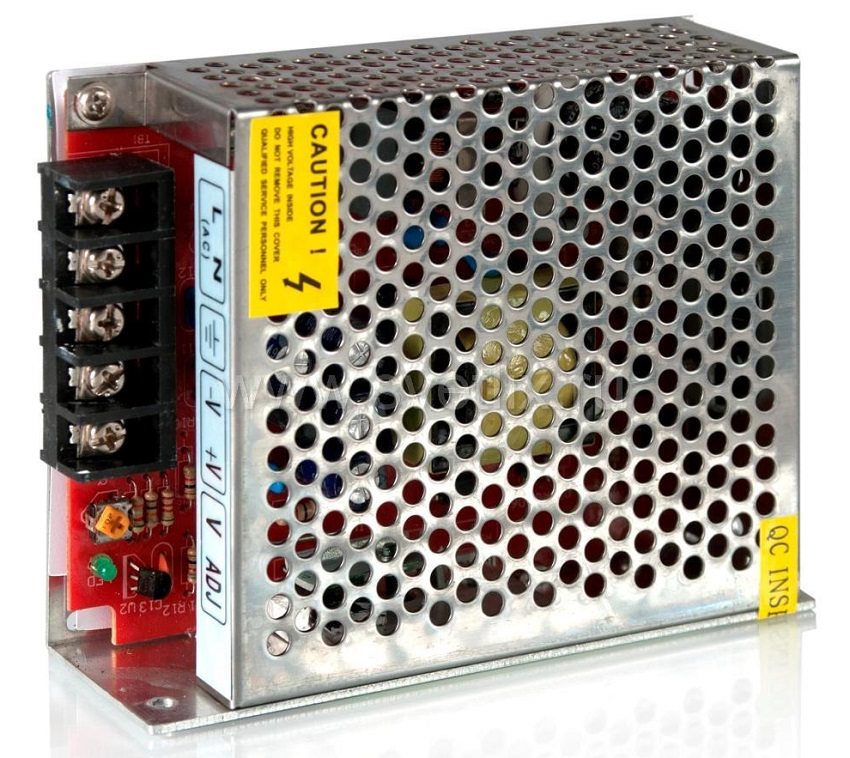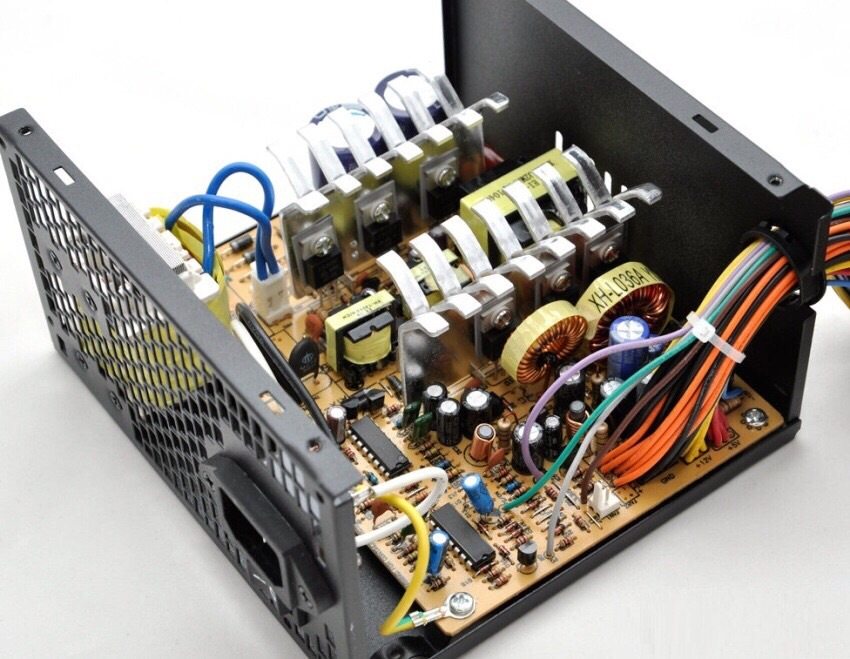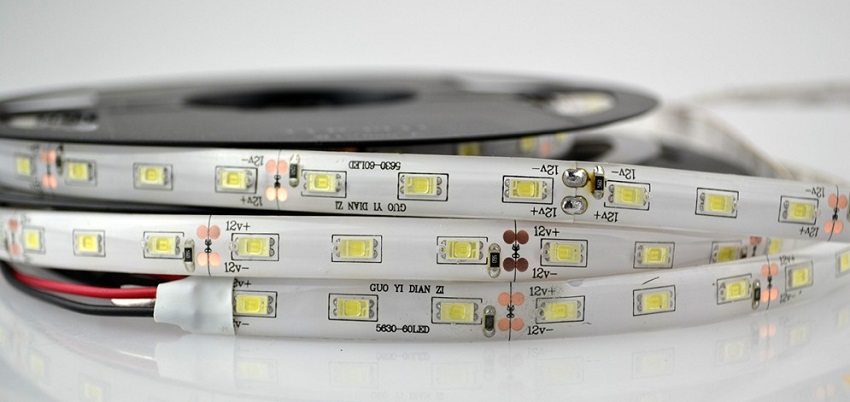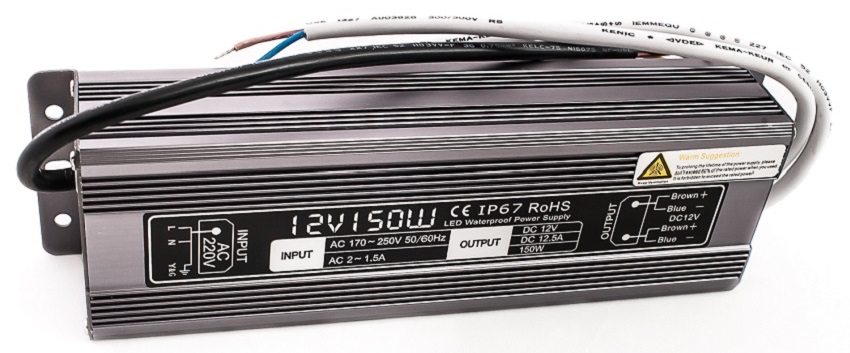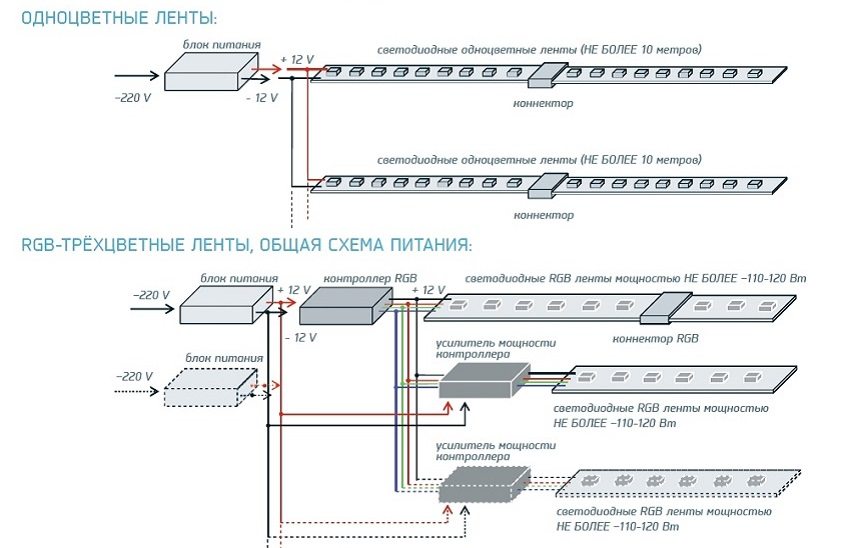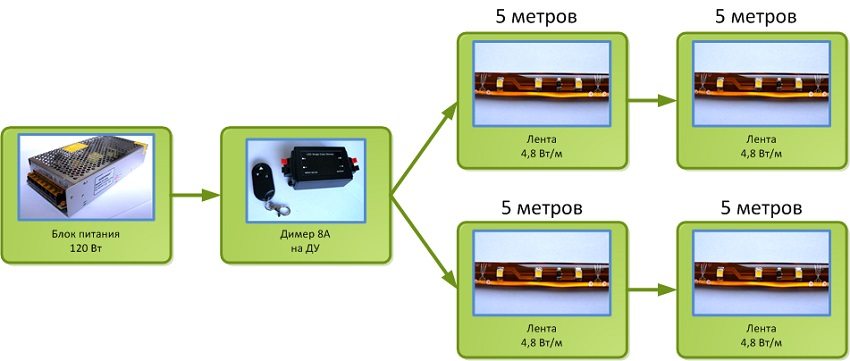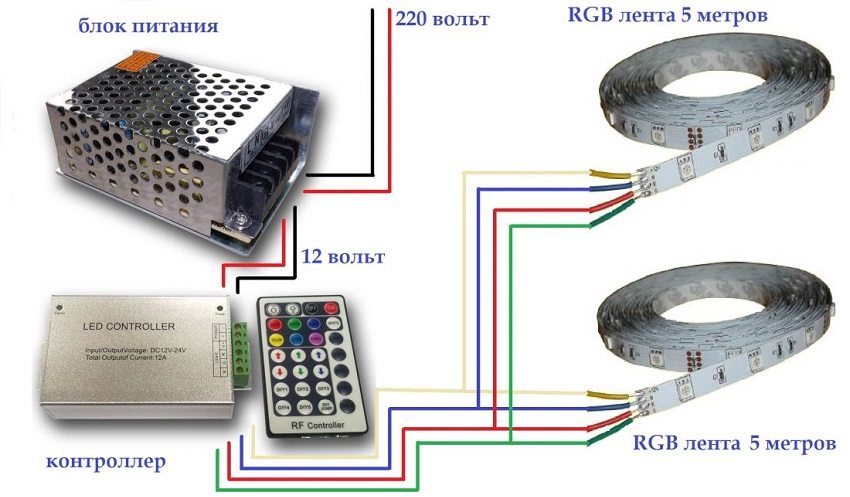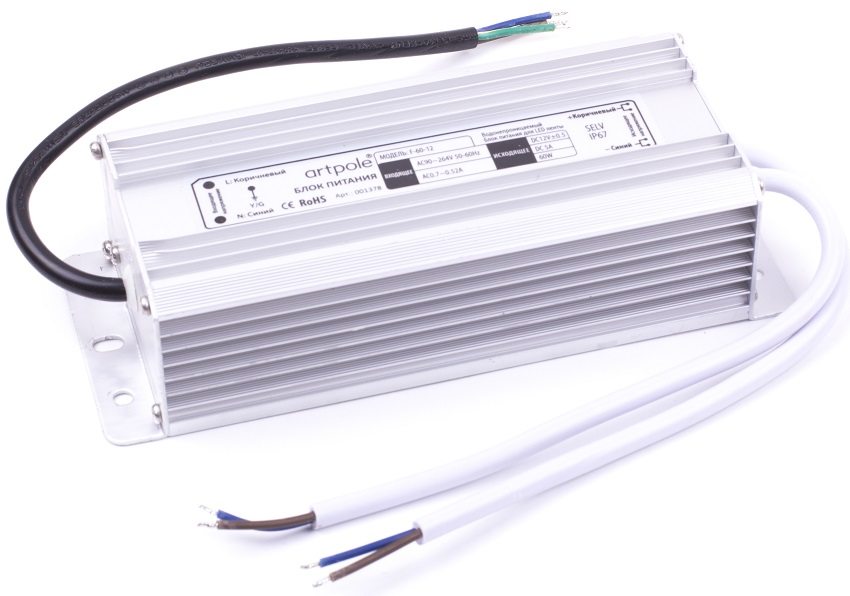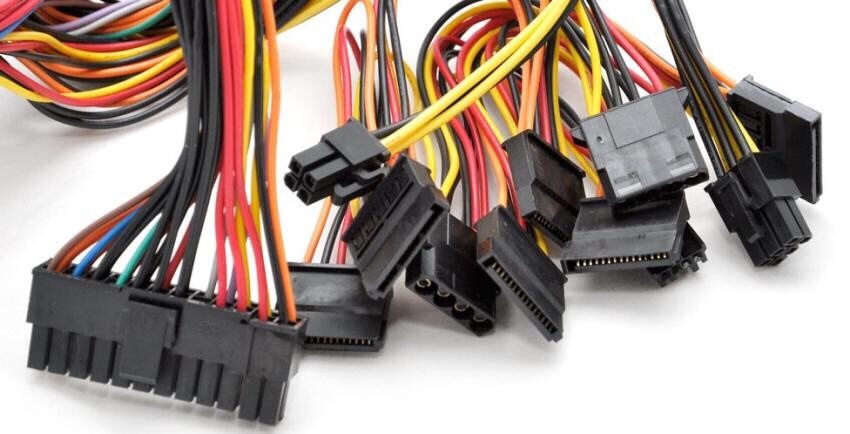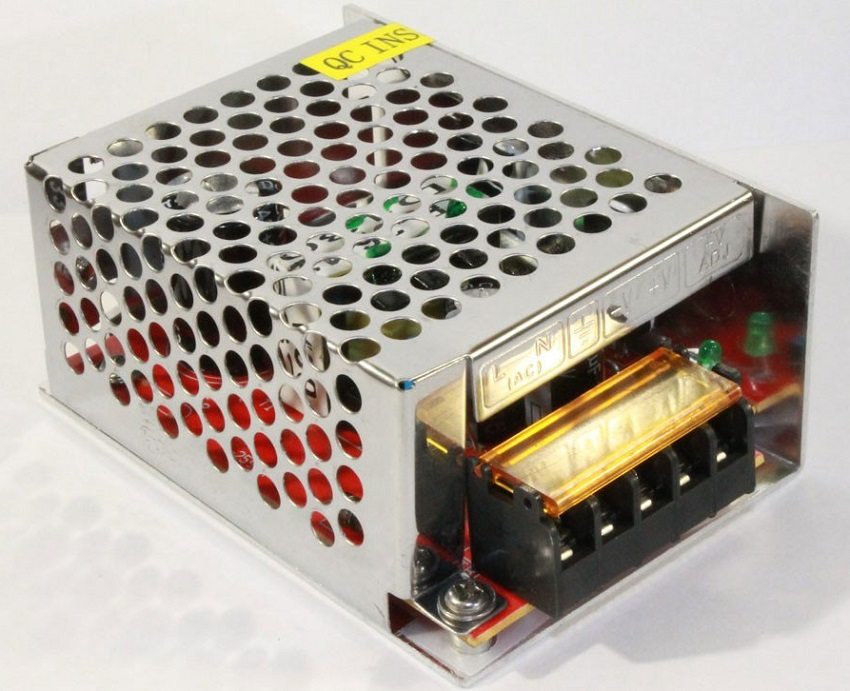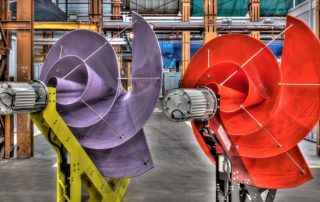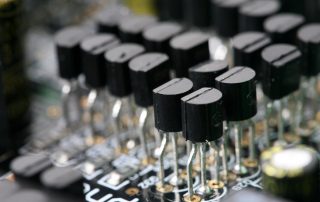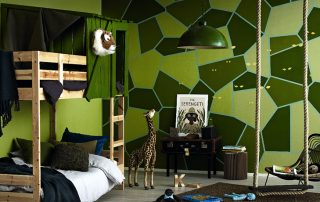Using LED backlighting in the interior, it is important that its work is stable, durable and does not have a harmful effect on human vision. The correct functioning of LED devices is ensured by voltage converters, which should be selected after performing some calculations. A properly selected power supply unit for a 12V LED strip will protect the LEDs from voltage surges and premature loss of glow quality.
Content [Hide]
Types of power supplies for 12 volt LED strips
Unlike conventional incandescent lamps, LED structures cannot be connected to a 220V network. They are available with 12V or 24V supply voltage. As a backlight in home interiors, 12V LED strips are most in demand. To obtain the required voltage, special adapters are used - power supplies that convert the voltage in the 220V network to the required value of 12V.
Before choosing a power supply for an LED strip, you should familiarize yourself with their types and characteristics. Stabilizers for LED products differ according to the following criteria:
- power - 5; fifteen; thirty; 60; 100; 150; 200 and 350 (W);
- functionality - provide only power supply, with built-in dimmer (dimmer) and / or with remote control;
- cooling system - with active and passive cooling. With an active system, a fan is built into the case, making a certain noise, which can cause discomfort;
- degree of protection - there are models that are sealed and not sealed;
- housing design - plastic, aluminum sealed for rooms with high humidity levels, metal with perforations and contact pads (used for dry rooms and requires installation in a closed place to avoid dust ingress).
Voltage stabilizers are a must for high quality lighting to ensure maximum efficiency of LED light sources. They supply LEDs electricity of the required parameters, protecting against possible voltage surges and premature failure. Thanks to the power supplies, the LED strips emit a uniform, flicker-free glow.
Power supply for 12V LED strip: calculation and connection of the device
To understand which power supply is needed for an LED strip, it is necessary to make certain calculations that take into account not only the output voltage, but also the amount of current supplied to the load. Therefore, for each specific backlight, you should calculate the total value of the current consumed by all LEDs in the tape.
Options for calculating the power supply for LED strip
Before calculating the power supply for the LED strip, you must familiarize yourself with the accompanying documentation for the product, which indicates the current consumption of one running meter. In the absence of such data, the calculation can be made independently.
For example, let's calculate the total number of LEDs for a 12V strip 15 m long, with a density of 30 SMD 5050 LEDs per meter: 15 (m) x 30 (pcs) = 450 pcs. Considering that each SMD 5050 LED consumes a current of 0.02A (this value is given in the diode parameter table), the total current consumption of the entire strip segment is 9A (450x0.02 = 9). Therefore, a 12V power supply with a 9A current carrying capacity will be required.
Helpful advice! Oversized power supplies are quite difficult to hide in the eaves structure. Therefore, for illumination of ceilings, it is not recommended to use tapes with a high density of LEDs, for which powerful converters are needed.
When calculating the power of the power supply for the LED strip, we multiply the voltage and the resulting current value: 12Vx9A = 108 W. Therefore, a stabilizer with a capacity of at least 108W will be acceptable. However, it should be noted that the unit is selected with a 20% power reserve, otherwise it will quickly fail from overload. This means that the required power will be: 108x1.2 = 129.6W, i.e., for this case, the choice of a power supply unit for a 12V LED strip - 150W will be optimal.
In addition, the power of the converter can be calculated using the data on the main characteristics of flexible LED products. Having chosen the desired type of tape, we find in the table the corresponding value of the power of one meter and multiply by the total length of the backlight. Given the power reserve, we get the required power of the power supply.
Table of the main technical indicators of 12V LED strips:
| LED class | LED size, mm² | LED strip power, W / m | Density of the tape, pcs / m | Luminous flux value, lm / m |
| SMD 3528 | 3.5x2.8 | 2,4 | 30 | 150 |
| 4,8 | 60 | 300 | ||
| 9.6 | 120 | 600 | ||
| SMD 5050 | 5x5 | 7,2 | 30 | 360 |
| 14,4 | 60 | 720 |
An example of connecting an LED strip to a power supply
It is necessary to mount the backlight to the selected surface after the power supply is connected to the LED strip. For example, let's use the connection of the tape to the block, the body of which is made of metal and has holes for cooling the constituent elements and the terminal strip. One of the casing walls is provided with a label indicating the marking for the correct connection of the wires.
Terminals marked "L" and "N" - phase and zero, are intended for connection to a 220V network. Grounding is marked with "FG" symbols. The terminals marked "G" are interconnected and are designed to connect the negative terminal of the LED strip. The three terminals marked "V" are also connected inside the adapter and the positive lead is connected to them, respectively. It should be noted that this marking is used on other models of converters.
To connect a single-color tape, we connect the wires to the terminals, taking into account the polarity. The power plug has three sheathed wires in brown, blue, and yellow-green. We attach the brown and blue wires to the "phase" and "zero" terminals, without fear of confusion, since they can be interchanged. The yellow-green wire is connected strictly to the ground terminal. If there is no grounding, the terminal is not used: it does not matter for the functioning of the tape.
Note! The absence of a grounding wire in the power cord is a violation of safety precautions when performing electrical work.
The above example of a diagram for connecting an LED strip to a power supply unit is suitable for using backlighting from one strip up to 5 m long. If you need to connect several pieces of tape, then you must use a parallel connection scheme.
Diagram of parallel connection of LED strip power supplies
If, when decorating an interior, it becomes necessary to highlight several decorative elements located at a certain distance from each other, parallel connection of tape segments to a voltage converter is used. Such a scheme is also used in the case when the lighting line of the structure is long enough and exceeds 5 m.
Sequential connection of the segments will lead to uneven distribution of the load, as a result of which the LED strip will not work correctly, emitting a weak light in the final section. It is possible that the extreme segment of the tape will not glow at all, while the initial one will start to overheat and quickly fail. This suggests that you cannot connect the end of the first segment to the beginning of the second.
When connected in parallel, each piece of LED strip must be independently connected to a power source. This can be done by connecting each piece of tape to the power supply with separate wires. But parallel connection can be done in another way: lay the main line of the wire from the converter, to which you can subsequently connect individual sections of the LED strip.
To make the contact of the tape conductors with the main wire reliable and strong, soldering or connection is used through special connectors - connectors. The use of connectors for connection greatly simplifies the repair of the backlight in the event that problems arise during operation. If the tape needs to be laid along a complex trajectory, the tape itself can be used as a trunk wire.

For a 12v power supply to last longer, you need to correctly calculate the power consumption of the diode module
The price of a power supply for a 12V LED strip
You can buy a power supply for 12V LED strip not only at points of sale of lighting equipment, but also on the web pages of manufacturers and organizations that sell LED products. There you can get acquainted with the range of models of converters, their technical characteristics and the cost of blocks.
By contacting site managers, you can get professional advice on how to choose a power supply for an LED strip, depending on its type and operating conditions. Experienced specialists will help you in choosing the right device, which will ensure durable and high-quality operation of the LED structure. As a rule, all products are certified and provided with a manufacturer's warranty.
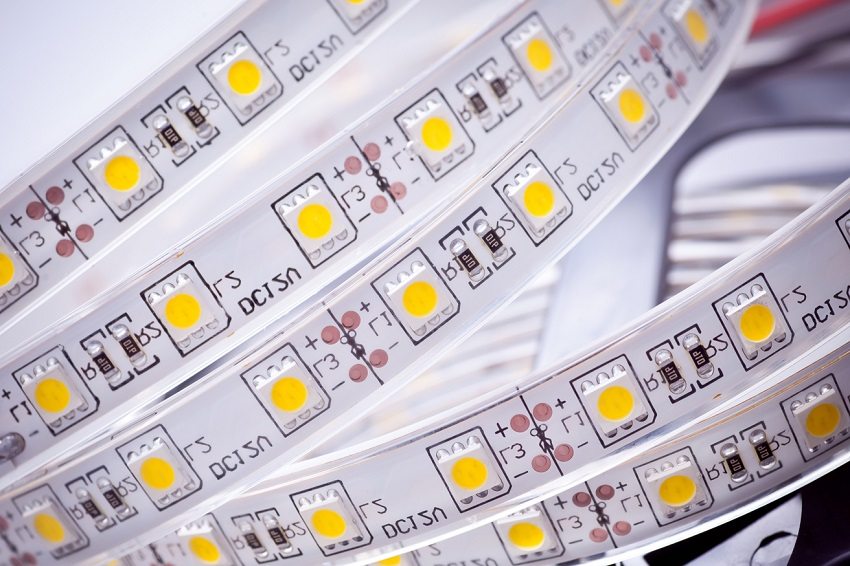
Each LED produces a luminous intensity of 3-21 lumens with a maximum power consumption of 19.8 watts
Note! When purchasing an open type transducer, remember that it can only be used in rooms with a minimum degree of humidity and in places where there is no risk of water ingress.
Before you buy a power supply for an LED strip, it is worth making an overview of the cost of products offered by different companies. This will help in choosing a model with the required parameters on favorable terms. Approximate prices of power supplies for 12V LED strip are presented in the table:
| Transducer model | Dimensions, mm | main parameters | price, rub. |
| Interior power supply unit 12V 15W IP 20 | 70/39/30 | Supply voltage 110-220V, power 15W, equipped with a power indicator and voltage regulator | 270 |
| Power supply unit 12V 35W IP 20 | 85/58/32 | Supply voltage 110-220V, power 35W, has a power indicator and voltage regulator | 380 |
| PSU 12V 60W IP 20 | 159/98/38 | Supply voltage 110-220V, power 60W, has a power indicator and voltage regulator | 540 |
| PSU 12V 150W IP 20 | 200/89/40 | Supply voltage 110-220V, power 150W, equipped with a power indicator and voltage regulator | 780 |
| Power supply unit waterproof 12V 30W IP 67 | 220/28/20 | Supply voltage 110-220V, power 30W, protection against moisture and dust | 560 |
| Power supply unit waterproof 12V 60W IP 67 | 148/40/30 | Power supply 110-220V, power 60W, protection against moisture and dust | 1100 |
| PSU waterproof 12V 100W IP 67 | 202/71,2/45 | Supply voltage 110-220V, power 100W, protection against moisture and dust | 1670 |
Sometimes there are situations when it is necessary to make illumination on a small section in length. Then the purchase of the power supply will cost much more than the purchase of the tape itself. In this case, you can make the converter yourself.
How to make a DIY LED strip power supply
The cost of switching power supplies for high power LED strip often exceeds the flex strip itself. However, there is an option to reduce the cost of a backlight device, using power supplies from outdated models of computers, TVs, tablets or other electrical appliances as a stabilizer. Surely such products can be found in every home.
The power of 12V converters from old electronics is usually 6 to 36W. This is quite enough for the functioning of a small segment of LED lighting, for example, a kitchen apron zone. You can use transformer models, but they are quite heavy and their power is twice the same parameter of the tape. As a result, when such a power supply is connected to the tape, it overheats a lot, even if it is improved by means of an additional cooling device.
For normal operation of the LED strip, it is better to use switching power supplies, which, with sufficient power, weigh very little. Suitable, for example, a converter for 12V and 2A from a failed TV. The power of such a device is 24W (12x2), which allows the LED strip to work properly, and the power supply does not overheat.
Helpful advice! 5V mobile phone chargers can be used as a power source for a hand-assembled small 3-6 LED night light.
It is possible to adapt the electronic ballast (current limiter), which powered the failed fluorescent lamp, under the power supply for the 12V tape. To do this, it is necessary to convert the regulator of the fluorescent lamp into a step-down transformer, after which, using the circuit, connect an LED strip to it. The conversion is a secondary winding, then a secondary diode and a capacitor are added to the circuit. The main condition is that the power of the tape must correspond to the same parameter of the ballast.
Repairing the power supply for LED strips
Failed 12V voltage sources can usually be adjusted. If you have enough knowledge and skills, you can try to repair the voltage converter yourself. Malfunctions can be eliminated using the power supply circuit for a 12V or 24V LED strip, as they are identical.
The most common problems with power supplies are as follows:
- capacitors C22, C23 fail - usually they are swollen or dry out;
- transistors T10-11 do not function;
- faulty PWM controller TL494;
- double diode D33, capacitors C30-33.
Malfunctions of other components of the converters are rare, but they are also worth checking.
To diagnose and fix problems, you need to do the following:
- open the housing and check the fuse. If everything is in order with him, it is necessary to measure the voltage across the capacitors (C22, C23), after applying power. The value should be around 310V. Therefore, the mains filter and rectifier are normal;
- diagnose PWM (KA7500 microcircuit) - if there is a voltage of 12-30V at pin 12, then we check the microcircuit. Otherwise, check the standby voltage power supply;
- the voltage at pin 14 after applying external power should be approximately + 5V. If not, you need to replace the microcircuit. If there is, it is necessary to check the microcircuit using an oscilloscope.
Repair of the power supply consists in replacing faulty elements with the same components or their analogues. In order not to subsequently face the problem of breakdown, it is necessary to follow the manufacturer's recommendations, since exceeding the permissible load limit will lead to the failure of the adapter.
Choosing the right power supply and related accessories for your LED systems will guarantee durability and quality of lighting. Thanks to these devices, LED sources emit bright, flicker-free light that can gracefully transform your interior.

